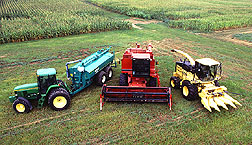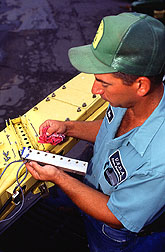High-Tech Retrofitting of Farm Machinery
|
|
As farming moves into the 21st century with tractors carrying satellite navigation receivers, radar guns, and computers, one thing hasn't changed do-it-yourselfers' ingenuity.
The urge of farmers to retrofit existing equipment to save money and perhaps do the job better is infectious. It spreads to private industry and government representatives who work with farmers. From this interchange, new farm equipment is born.
So it should be no surprise to see this old-fashioned ingenuity blossoming with futuristic precision agriculture in equipment sheds at the Beltsville (Maryland) Agricultural Research Center, or BARC, which is part of USDA's Agricultural Research Service.
Precision agriculture means farming with on-the-go monitoring of yields and soil types, as well as of chemical and manure applications. Global Positioning System (GPS) satellites are used to spatially locate tractors and other farm equipment in a field.
In the BARC equipment yard, Dan Shirley sits in the cab of a tractor towing a liquid manure tank. He chuckles at the thought that "not for a minute did the manufacturer of this 486 computer think it would be used to control manure flow rates."
The tractor typifies space-age agricultural tools: It sports a roof antenna for satellite signals, a GPS receiver in the cab, and a radar gun below the cab's floor, to monitor ground speed. Shirley heads a team of eight who form the land operations branch for the east section of the 7,000-acre research farm. They are essentially the farmers who see that the crops get planted and the machines work.
|
|
Shirley and other crew members use the equipment to make the center's farming more sustainable economically and environmentally. The gear is also used in BARC's precision farming projects.
The center has a variable-rate liquid manure applicator thanks primarily to crew member John Bouma, nicknamed "The Fabricator."
Bouma also devised one of the few silage harvesters in the world with on-the-go yield monitoring.
Rockwell International gave Bouma a GPS receiver and computer and a pair of light-beam sensors. The parts came with no directions, but Bouma figured them out himself, wearing various hats including those of mechanic, welder, engineer, and researcher. He wore his pit-stop hat, toobuilding a bracket that not only keeps the sensors aligned, but also allows their removal and reinstallation in 2 minutes. That's so the sensors can be cleaned between silage loads without affecting the alignment.
This bracket sandwiches the sensors on the tube that sucks up harvested silage. The two sensors send light beams to each other, through holes drilled in the tube. The denser the silage stream, the less light reaching the sensors, indicating a higher yield.
Not only did Bouma come through, but he put on an artist's hat for his standard final touch to equipment modifications: painting the bracket the same yellow as the New Holland silage harvester.
Bouma succeeded so well with the silage harvester that Rockwell has sold two farmers on copying him.
Bouma also added a variable rate capability to spreaders used to apply dry fertilizer as well as liquid manure. His next assignment: do the same with a dry-manure spreader. — By Don Comis, Agricultural Research Service Information Staff.
Dan Shirley is with the USDA-ARS Farm Operations Branch, Bldg. 301, 10300 Baltimore Ave., Beltsville, MD 20705-2350; phone (301) 504-8448, fax (301) 504-8403.
"High-Tech Retrofitting of Farm Machinery" was published in the November 1998 issue of Agricultural Research magazine. Click here to see this issue's table of contents.








